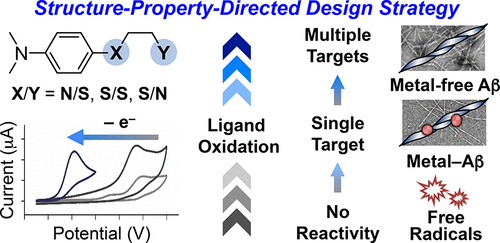当前位置:
X-MOL 学术
›
ACS Chem. Neurosci.
›
论文详情
Our official English website, www.x-mol.net, welcomes your
feedback! (Note: you will need to create a separate account there.)
Tuning Structures and Properties for Developing Novel Chemical Tools toward Distinct Pathogenic Elements in Alzheimer’s Disease
ACS Chemical Neuroscience ( IF 4.1 ) Pub Date : 2017-12-28 00:00:00 , DOI: 10.1021/acschemneuro.7b00454 Jiyeon Han 1 , Hyuck Jin Lee 2 , Kyu Yeon Kim 3 , Shin Jung C. Lee 1 , Jong-Min Suh 1 , Jaeheung Cho 4 , Junghyun Chae 3 , Mi Hee Lim 1
ACS Chemical Neuroscience ( IF 4.1 ) Pub Date : 2017-12-28 00:00:00 , DOI: 10.1021/acschemneuro.7b00454 Jiyeon Han 1 , Hyuck Jin Lee 2 , Kyu Yeon Kim 3 , Shin Jung C. Lee 1 , Jong-Min Suh 1 , Jaeheung Cho 4 , Junghyun Chae 3 , Mi Hee Lim 1
Affiliation

|
Multiple pathogenic factors [e.g., amyloid-β (Aβ), metal ions, metal-bound Aβ (metal–Aβ), reactive oxygen species (ROS)] are found in the brain of patients with Alzheimer’s disease (AD). In order to elucidate the roles of pathological elements in AD, chemical tools able to regulate their activities would be valuable. Due to the complicated link among multiple pathological factors, however, it has been challenging to invent such chemical tools. Herein, we report novel small molecules as chemical tools toward modulation of single or multiple target(s), designed via a rational structure-property-directed strategy. The chemical properties (e.g., oxidation potentials) of our molecules and their coverage of reactivities toward the pathological targets were successfully differentiated through a minor structural variation [i.e., replacement of one nitrogen (N) or sulfur (S) donor atom in the framework]. Among our compounds (1–3), 1 with the lowest oxidation potential is able to noticeably modify the aggregation of both metal-free Aβ and metal–Aβ, as well as scavenge free radicals. Compound 2 with the moderate oxidation potential significantly alters the aggregation of Cu(II)–Aβ42. The hardly oxidizable compound, 3, relative to 1 and 2, indicates no noticeable interactions with all pathogenic factors, including metal-free Aβ, metal–Aβ, and free radicals. Overall, our studies demonstrate that the design of small molecules as chemical tools able to control distinct pathological components could be achieved via fine-tuning of structures and properties.
中文翻译:

调整结构和性能,开发针对阿尔茨海默病的独特致病元素的新型化学工具
在阿尔茨海默氏病(AD)患者的大脑中发现了多种致病因素[例如淀粉样β(Aβ),金属离子,与金属结合的Aβ(金属–Aβ),活性氧(ROS)]。为了阐明病理因素在AD中的作用,能够调节其活性的化学工具将是有价值的。然而,由于多种病理因素之间的复杂联系,因此发明这样的化学工具一直是具有挑战性的。在这里,我们报告了新颖的小分子,作为化学工具,可通过合理的结构-属性-导向策略设计,用于调节单个或多个目标。我们分子的化学性质(例如,氧化电位)及其对病理学靶标的反应性覆盖范围通过微小的结构变异[即,框架中一个氮(N)或硫(S)供体原子的替代]。在我们的化合物中(1 - 3),1具有最低的氧化电位是能够显着地修改都无金属Aβ和金属Aβ的聚集,以及清除自由基。具有中等氧化电位的化合物2会显着改变Cu(II)–Aβ 42的聚集。相对于1和2,几乎不可氧化的化合物3表示与所有致病因素(包括无金属的Aβ,金属的Aβ和自由基)没有明显的相互作用。总体而言,我们的研究表明,可以通过微调结构和特性来实现将小分子设计为能够控制不同病理成分的化学工具。
更新日期:2017-12-28
中文翻译:

调整结构和性能,开发针对阿尔茨海默病的独特致病元素的新型化学工具
在阿尔茨海默氏病(AD)患者的大脑中发现了多种致病因素[例如淀粉样β(Aβ),金属离子,与金属结合的Aβ(金属–Aβ),活性氧(ROS)]。为了阐明病理因素在AD中的作用,能够调节其活性的化学工具将是有价值的。然而,由于多种病理因素之间的复杂联系,因此发明这样的化学工具一直是具有挑战性的。在这里,我们报告了新颖的小分子,作为化学工具,可通过合理的结构-属性-导向策略设计,用于调节单个或多个目标。我们分子的化学性质(例如,氧化电位)及其对病理学靶标的反应性覆盖范围通过微小的结构变异[即,框架中一个氮(N)或硫(S)供体原子的替代]。在我们的化合物中(1 - 3),1具有最低的氧化电位是能够显着地修改都无金属Aβ和金属Aβ的聚集,以及清除自由基。具有中等氧化电位的化合物2会显着改变Cu(II)–Aβ 42的聚集。相对于1和2,几乎不可氧化的化合物3表示与所有致病因素(包括无金属的Aβ,金属的Aβ和自由基)没有明显的相互作用。总体而言,我们的研究表明,可以通过微调结构和特性来实现将小分子设计为能够控制不同病理成分的化学工具。











































 京公网安备 11010802027423号
京公网安备 11010802027423号